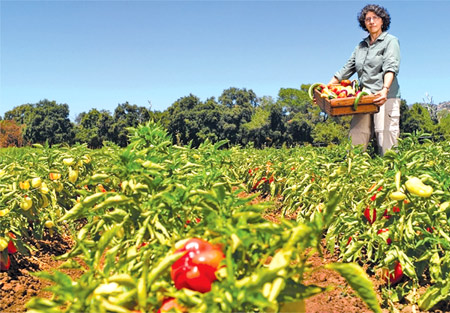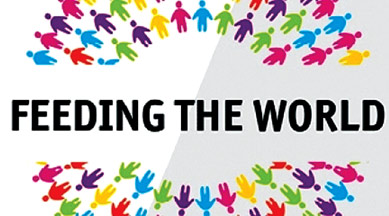Feeding the world, the ultimate First-World conceit
The problem of world hunger should be
addressed where it lies - by increasing small-scale food production,
particularly among women.
by Timothy A. Wise
Since the food price spikes of 2007-8, global hands have been
wringing over the question, how will we feed the world? Population keeps
growing, food-producing resources like land and water become more
scarce, climate change introduces a dramatic uncertainty.
 The images are downright Malthusian. The urgent recommendation is to
produce more food, quickly. It is the theme of this year's World Food
Prize. The images are downright Malthusian. The urgent recommendation is to
produce more food, quickly. It is the theme of this year's World Food
Prize.
The question is fundamentally flawed, as is the Malthusian panic.
There is no "we" who feed the world. There are, mostly, hundreds of
millions of small-scale farmers. And there is no abstract "world" out
there needing to be fed. There are about one billion hungry people,
nearly all in developing countries. The majority are some of those same
small-scale farmers. The rest are poor because they are unemployed or
underemployed.
Increasing the industrial production of agricultural commodities does
almost nothing for these people. Oddly enough, it can even make them
hungrier.
Who feeds whom?
In practice, "we" all know whom "we" mean when we ask how "we" will
feed the world. We mean industrialized societies, with their high-yield
industrialised agriculture. But industrialized farms produce only 30
percent of the food consumed in the world today. Seventy percent is
produced by small-scale farmers. And it's mostly not traded across
borders; only 15 percent of food is traded internationally.
Eighty-five percent is consumed by the farming household, traded
locally, or sold in domestic markets.
Conceit
The conceit that first-world farmers feed the hungry is just that:
conceited.
What industrialised agriculture produces are agricultural commodities
that serve as raw materials - occasionally as food, often as animal
feed. It produces a lot of those raw materials, and the output has a lot
to do with international prices for food commodities.
But the volume of that production has very little to do with whether
the hungry are fed.
 By some estimates, we currently grow enough food today to feed ten
billion people, more than the projected global population in 2050. By some estimates, we currently grow enough food today to feed ten
billion people, more than the projected global population in 2050.
The hungry are hungry not because there isn't enough food but because
they don't have the incomes to buy it. Or to grow it. An estimated 70
percent of the hungry in the world today live in rural areas.
They can end up hungrier because of higher production of agricultural
commodities. Cheap, industrialized rice or corn comes as a double-edged
sword. If the farmers have any cash, lower prices mean they can afford
more food.
But if they grow these same crops, the prices they can get for their
own rice or corn are lower thanks to the international competition. So
they have less cash.
Studies have shown that high crop prices are better for the rural
poor, even if they drive up the cost of food. Why? Money flows to the
domestic agricultural economy, spurring investment, creating jobs, and
raising wages.
There are two ways to better feed the hungry: increase the amount of
food they can produce or create decent work for them. Industrialized
agriculture does neither of these things well.
Environments
Its technologies are poorly suited to the needs and environments of
small-scale developing-country farmers. Hybrid seeds and chemical inputs
all cost money; few small-scale producers can afford them without
government subsidies, and even then they often lack the credit they need
to sustain the cash demands of industrial production.
In Malawi, few farmers could afford the recommended second
application of fertiliser, leaving their hybrid maize yields little
better than if they had used traditional seeds.
What about creating jobs? Industrialised agriculture is
capital-intensive, not labour-intensive. By definition, it increases
productivity by substituting technology - tractors, irrigation, chemical
inputs, seeds - for labour. Each kilo of rice might be a little cheaper
as a result, but the number of people who get an income from that
production is often dramatically reduced. If the high-yield rice
displaces small-scale rice producers, the net impact on jobs and
livelihoods can be negative.
But can't societies just jump-start development by bringing in
foreign capital and expertise? That is the premise of the US
Administration's New Alliance for Food Security and Nutrition, which
seeks to infuse private capital into African agriculture through the
magic of "public-private partnerships."
At best, such investments will develop only land, not societies.
- Third World Network Features.
|

